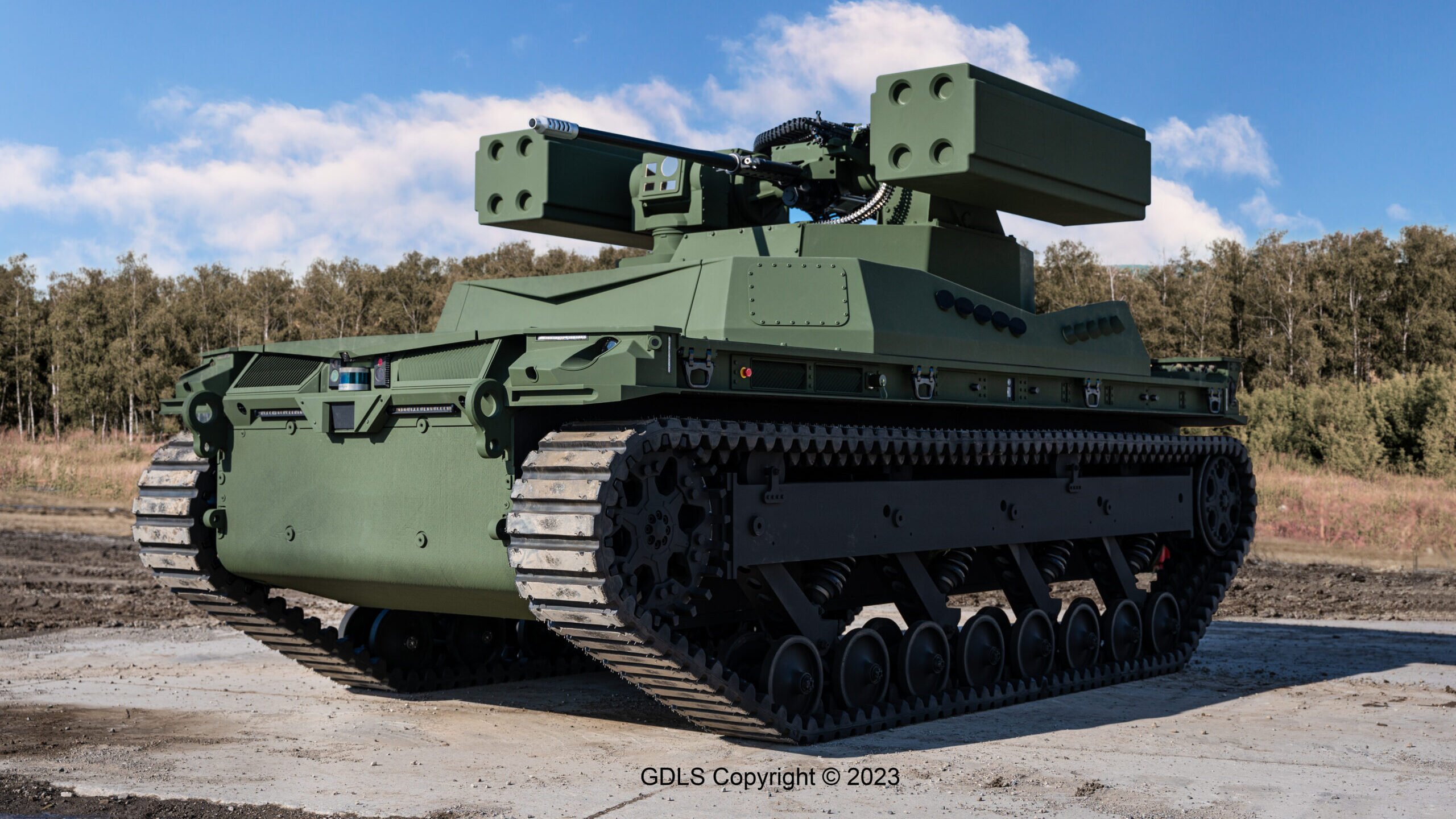
Shown here the GDLS d will have its TRX outfitted with Moog’s Reconfigurable Integrated-weapons Platform (RIwP) as a SHORAD payload. (GDLS)
Global Force 2023 — The US Army may be tight-lipped about its requirements for its upcoming Robotic Combat Vehicle competition next year, but one contender, General Dynamics Land Systems, its taking the opportunity to show of its planned entry at Global Force 2023: the Tracked Robot 10-Ton (TRX) demonstrator, this time outfitted with a new, short-range air defense (SHORAD) payload.
The service released its initial RCV solicitation earlier this year marked with the “controlled unclassified information” designation, meaning details are scarce and industry can’t openly discuss the plan. Additionally, the Army has not responded to Breaking Defense’s request for details, though it did confirm that it is requesting $142 million in fiscal 2024 to kickstart a prototyping competition.
Despite lingering questions about size and capability requirements, GDLS officials confirmed last week that the company’s TRX demonstrator, once billed as a possible “RCV-Medium” contender, will be its entry point into the competition.
“The TRX offers an innovative solution for some of the Army’s force structure challenges, but also, and more importantly, to address many of the dirty, dull and dangerous missions with a innovative multi-payload capable RCV,” Scott Taylor, the company’s director for US business development, told Breaking Defense during a March 21 interview.
As the demonstrator’s name suggests, the vehicle is designed to weigh up to 10 tons — five tons as the vehicle’s curb weight and the ability to carry a five-ton payload. Over the past several years, the company has incrementally announced new payloads it has integrated onto the vehicle’s flat-bed and tested out with the Army. Those have included ones for tactical resupply missions, AeroVironment’s Switchblade 600 loitering weapon system and an obstacle-reduction package from Pearson Engineering for breaching missions.
GDLS saved their most recent configuration, one outfitted with with Moog’s Reconfigurable Integrated-weapons Platform (RIwP) as a SHORAD payload, for an unveiling at this year’s Association of the US Army’s Global Force show here in Huntsville, Ala.
That turret is the same one used on the Army’s Stryker-based Mobile-SHORAD program and includes a modified M299 launcher for two Longbow Hellfire missiles, a Raytheon Stinger Vehicle Universal Launcher to hold four surface-to-air missiles, Northrop Grumman’s XM914 30mm Bushmaster Chain Gun, and an M240 7.62mm machine gun. GDLS is leading the initiative and working with Leonardo DRS.
The company has now “integrated” that RIwP configuration onto its TRX but has not yet demonstrated it, according to Ray Moldovan, GDLS’s manager for US business development focusing on robotics.
“We wanted to maintain commonality with [M-SHORAD] so that the Army sees something they’re familiar with and we bring them the capability on a robotic platform,” Moldovan added.
Of course, GDLS is not the only big company expected to compete for a spot in the prototyping competition. A BAE Systems company spokesperson told Breaking Defense in a short statement on March 27 that the company is reviewing information from a recent RCV industry day and awaiting the release of a full request for proposal.
“Our vast experience in autonomy, our platform options and our expertise in combat vehicle manufacturing makes this an interesting opportunity,” the spokesperson added.
Other companies have not yet announced plans to join the competition, but could do so over the next few months, including some who have produced similar prototypes in the past.
RCV’s Evolving Plans
In recent years, Army officials have continued to evolve plans to acquire an RCV fleet. Initially they envisioned moving forward with three RCV sizes: a Light version weighing less than 10 tons, a Medium sized one between 10 and 20 tons, and a Heavy robot weighing in between 20 and 30 tons.
But, after acquiring four light ones from QinetiQ North America and Pratt Miller, since acquired by Oshkosh Defense, based on a “variant” of the Expeditionary Modular Autonomous Vehicle, and four medium prototypes from a Textron Systems, Howe & Howe Technologies, and FLIR Systems team, the Army decided that they should first focus on the smaller category to focus on improving reliability.
“Having a system that can take that first shot rather than having them be the person that takes the first shot is really powerful,” Director of the Next Generation Combat Vehicles Cross Functional Team, Brigadier General Geoffrey Norman, told reporters on 11 October. “But they need that robot to be reliable and they need to be able to trust it where they tell [it] to go, and [the robots] can go there without [soldiers] having to intervene.”
Accordingly, the service planned to operate the four RCV-L prototypes in last year’s Project Convergence 2022 event and then use those findings to finalize requirements for an RCV-L prototyping competition.
But it’s not clear if the Army has since decided to merge RCV-L and RCV-M size and weight specifications for the prototyping competition, which may explain the planned entry of GDLS’s formerly “Medium” candidate. However, as of last year, the RCV-L plans included two parallel efforts: the first revolving around continued experimentation with the existing four RCV-Ls, and the second around this competition.























